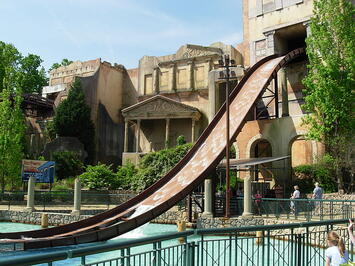
Pulling into the giant parking lot of Busch Gardens Williamsburg is like any other theme park experience: a large entry gate with booths to pay for overpriced parking, vast themed lots based on European countries, and a long walk to where a shiny and sleek tram picks you up and an announcer shares park details. I decided to take my son to the park as we were staying nearby and, as safety during the pandemic has greatly improved, I figured that he would enjoy the rides and fantasy. Almost 7 hours later, despite oppressive heat and humidity, I had had one of the greatest theme park experiences in recent memory.
Of course, I loved watching my little one marvel at the rides, characters, and theming. But what really made the day “magical” is that the Williamsburg, Virginia park had exactly what is missing from some of the larger theme parks like Disney: spontaneity and a bit of disorder, which is exactly what made it so exciting.
When one visits a Disney park, for instance, there is very little left to chance. These parks are heavily controlled: perfectly planned environments with local topography all but removed. There has been careful central planning to allow for easy movement and crowd control all while hiding mechanics and reality. Interactions with characters and ride experiences are inauthentically scripted and fleeting, presenting visitors with a carefully controlled narrative, and seemingly unending opportunities to buy products reminding guests that their experience has been both magical and enchanting.
Moreover, because Disney parks are so crowded and popular, there are hundreds of websites chronicling every facet and nuance of every attraction under the sun. Disney encourages its guests to book rides and experiences weeks in advance; failure to do this can result in endless lines and astronomical wait times. Experiencing the attractions in any unplanned way is virtually impossible. While tens of millions love these pre-planned facets of a Disney experience the soul-crushing process of scheduling everything well in advance is anything but magical.
Bush Gardens, in contrast, is messy and thrilling. The park first opened in 1975 – four years after Disney’s Magic Kingdom. It has developed gradually, taking advantage of local topography and geography without the forced perspective and cinematic flare of Disney. There is no clear center of the park, and rides and attractions have been fitted into the valleys and hills of the environment. A number of bridges squeeze guests into close proximity. There is an overall sense of exploring a terraced Virginia woodland, because unlike Disney, Busch Gardens is not a perfectly planned spoke and wheel – guests can reach various attractions through numerous paths – and shopping and merchandizing was in the park, but was certainly not omnipresent.
While Busch Gardens does have a small program to help visitors minimize wait times in line, guests aren’t absorbed in their phones, using apps to book ride times and schedule every minute of the day. In my case, if one area or ride was too crowded, we simply moved on and found another attraction that had space. We moved around freely– crossing bridges and exploring the various themed areas of the park running into performances randomly. It’s worth noting that while Disney parks are known for their huge crowds, Busch Gardens isn’t some minor attraction: It’s rated as one of the nation’s best parks and attracts close to 3 million visitors a year.
The fact is the matter is simply this: Busch Gardens was planned and runs differently from better-known theme parks. Its scale is smaller, and the experience is far more chaotic. But for me and my family, Busch Garden’s is also so much more exciting. The chaos, randomness, and ability to discover and be spontaneous is exactly what the Disney parks lack. Decades of social science and work in urban theory has revealed that great places develop when “unexpected positive experiences” can occur, and Bush Garden’s topography and approach to the park absolutely facilitate such interactions and behaviors. Theorists from Jacobs to Sennett to Glaeser have all documented the values of random encounters and experiences and that can genuinely happen at Busch Gardens.
Of course, Disney’s “Imagineer” planners do understand the value of the unexpected and have tried to add some spontaneity into their rides through array of outcomes, but the fact remains that Disney parks have effectively eliminated the possibility of meaningful chance encounters. At Busch Gardens, there is still ample opportunity for spontaneity, chaos, and many surprises which collectively help create spaces both authentic and joyous. While I will no doubt revisit Disney down the road (their marketing will almost certainly reach my little one, one day), I will not forget the real joys of place where you can live in the moment and let the day unfold – without a schedule and with just a touch of chaos thrown in.
Samuel J. Abrams is professor of politics at Sarah Lawrence College and a visiting scholar at the American Enterprise Institute.
Photo: Piotrus via Wikimedia under CC 3.0 License.












